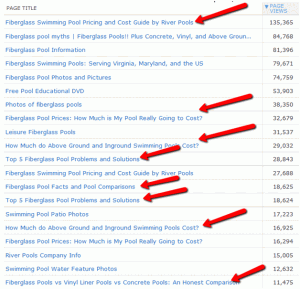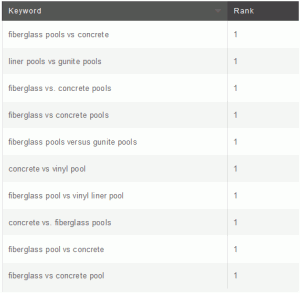When I consulted with enterprise tech companies, I loved working with the Competitive Sales Office.
We humans just like being on a team, sometimes thrive on that “us against them” mentality. And, hey, if this year’s Presidential primaries have taught us anything, it’s that the simplest tactic to get a lift is to point out your opponent’s flaws (even if you have the same flaws yourself).
But let me rock your boat for just a moment, and suggest …
Maybe your competitors aren’t so bad after all
If they’ve been able to stay in business, they’ve probably been able to serve the needs of at least some customers. Which means — maybe, just maybe — some of your potential customers might be better served by your competitor’s product than by yours … at least for some purchase decisions.
For example, thank you for reading the MarketingExperiments blog, but if you’re looking for the latest social media news, let me refer you to one of our competitors — Mashable. We simply don’t cover social media news. We report on results … what really works.
To come around to this mindset, you first have to admit that your product is not a Fine -Something-That-All-People-Need. This can be exceedingly difficult. Who wants to feel like a traitor to the team?
But here’s the upside for your marketing: when you’re actually helping your customers find the best solution, they’ll believe you when you really are the best solution for their needs. Read how Dr. Flint McGlaughlin, Managing Director, MECLABS, explained it in Transparent Marketing: How to earn the trust of a skeptical customer …
Admit your Weaknesses
The Postmodern Consumer is not looking for perfection. He is looking for honesty. He wants to build a relationship with someone or with some company that he can trust. Best-selling authors Jack Trout and Al Ries espouse this vital principle.
“Why does a dose of honesty work so well in the marketing process? First and foremost, candor is very disarming. Every negative statement you make about yourself is instantly accepted as truth. Positive statements, on the other hand, are looked at as dubious at best.”
When a company is humble enough to admit a weakness, they immediately distinguish themselves from the competition. It opens the door for a trust relationship.
The consumer is all too aware of the fact that we are not perfect. To pretend otherwise only serves to raise their suspicion. Tell them what you can’t do, and they’ll believe you when you tell them what you can do.
As Emily Dickinson said, “The truth must dazzle gradually. ”
Real content marketing adds value for the customer no matter what the topic is
So I was excited to be sitting in the audience at MarketingSherpa Email Summit 2012 and hear Marcus Sheridan, co-owner, River Pools and Spas, share how transparent marketing was a successful practice for his company.
“We all have products meant for specific people, and for some folks, it is not a good fit. If you can fully admit this, you become a transparent marketer,” Marcus said.
A pool is a complex purchase, and potential customers have a lot of questions. Instead of avoiding them or simply trying to overpower these concerns with marketing hype, River Pools and Spas behaved like a true content marketer and provided information to the potential customers to help them answer their questions by writing blog posts like …
Top 5 Fiberglass Pool Problems and Solutions
Fiberglass Pools vs Vinyl Liner Pools vs Concrete Pools: An Honest Comparison
Now many companies are willing to write that second post, but it would usually include only reasons why the product they sell is better than the competition. I’m no pool expert, but the River Pools and Spas post looked like a pretty fair assessment (even if it obviously isn’t unbiased) with clear advantages and disadvantages for each type of pool.
“Fiberglass might be too skinny, but if you’re looking for that size, it can be good for you,” Marcus said. “We tell potential customers, ‘You know what, fiberglass might not be for you. And that’s OK, we’re going to figure it out together.’”
But does this strategy work? Let’s take a look at the results …

The “problems post” garnered 176 comment, 396 inbound links, and 43,867 page views.

The “honest comparisons” post received 11,475 page views. Even better, River Pools and Spas ranked number one in Google for several comparison-based phrases.

Most importantly, these keywords generated the second-most leads of any keywords (second only to branded keywords, such as “River Pools and Spas,” which usually indicate extremely high motivation on the part of the potential customer).
And these blog posts aren’t just an inbound channel. Every potential customer who enters River Pools’ funnel gets an article about problems with fiberglass pools.
“Customer says, ‘This guying isn’t pitching me, we’ll figure it out together,’” Marcus said. “We are very transparent with our marketing, and because of that, we get respect.”
Writing blog posts where you admit your weaknesses is only one example. To get your creative juices flowing, here are two other places you might want to tell customers what you can’t do (so they’ll believe you when you tell them what you can) and one place where this strategy might not be a good fit:
Content curation – Not every marketer is able to publish all of their own high-quality content yet. However, even with content curation (finding, organizing and sharing online content), your focus should be on an honest conversation with potential customers that is focused on helping them make the best decision (not pushing product).
“What some companies may not know is that curating content from their competitors may actually give them the advantage,” according to Pawan Deshpande, CEO, Hivefire.
“If a company’s goal is to keep their audience engaged by sharing the most newsworthy content — created both internally and by third-party sources around the Web — there may be times when that content is coming from competitors. In this case, sharing content from a competitor will not only establish a company’s site as a ‘one stop’ resource for readers, it will also position them as an authoritative source for industry knowledge and allow them to engage better in the conversation.”
Sales – If, as is all the rage, you practice solution selling, then your focus should be on finding the best solutions for your potential customers.
“We’re not right for people all the time,” Jessica Best, Community Director, emfluence, readily admitted. “I just had lunch with a gal last week who’s sending an email a week to each of seven lists and each list has about 1,500 people on it.”
“I talked with her for an hour and a half about improving her list growth strategies, the features that were important to her… and then I recommended she look into AWeber and MailChimp. We’re just not a fit for her. We can focus on being great at what we do, let our buddies at other ESPs do what they do best, too, you know?”
And the reaction when Jessica handles potential customers this way …
“Usually they’re just grateful to get a little direction/help. When they realize I’m not going to try and sell them my product because it’s not a good fit, they trust my recommendation even more so. And I’ve had these contacts refer business my way when someone is a good fit for me, because I’ve made it clear what is and isn’t a good fit for my product.”
“Honestly, when people stop being afraid you’ll sell them something they don’t need, they start listening to what you can do for them (or if not them, someone else).”
Targeted, paid media – Now here is the one exception you might want to consider. When you’re paying for the space, it is at a premium, and you might not want to waste space on what you can’t do, but rather focus on the true value in your marketing proposition.
“I appreciate the value of candor and transparency, especially in today’s socially charged world, but highlighting a weakness isn’t something I’ve often done,” admitted Michael Nelson, Account Executive, CRT/tanaka.
“The reason isn’t that we wouldn’t want to admit a lack of perfection, but in marketing you have such limited space and time. If you can only rattle off one to three messages, it’s difficult to focus on something your product doesn’t do well.”
Also consider, proper targeting can help reduce (although not eliminate) sending your message to an unqualified audience, as Michael elaborates …
“The things we market are designed for certain cohorts and demographics. Though what we’re marketing may have weaknesses for a broad population, it might truly be perfect for the audience being targeted.”
Related Resources:
Transparent Marketing and Social Media: Twitter and Facebook are the new Woodward and Bernstein
Transparency and Inbound Marketing: The Greatest ‘Sales Technique’ of the Information Age



